check oil Hyundai Accent 2005 User Guide
[x] Cancel search | Manufacturer: HYUNDAI, Model Year: 2005, Model line: Accent, Model: Hyundai Accent 2005Pages: 219, PDF Size: 7.07 MB
Page 156 of 219
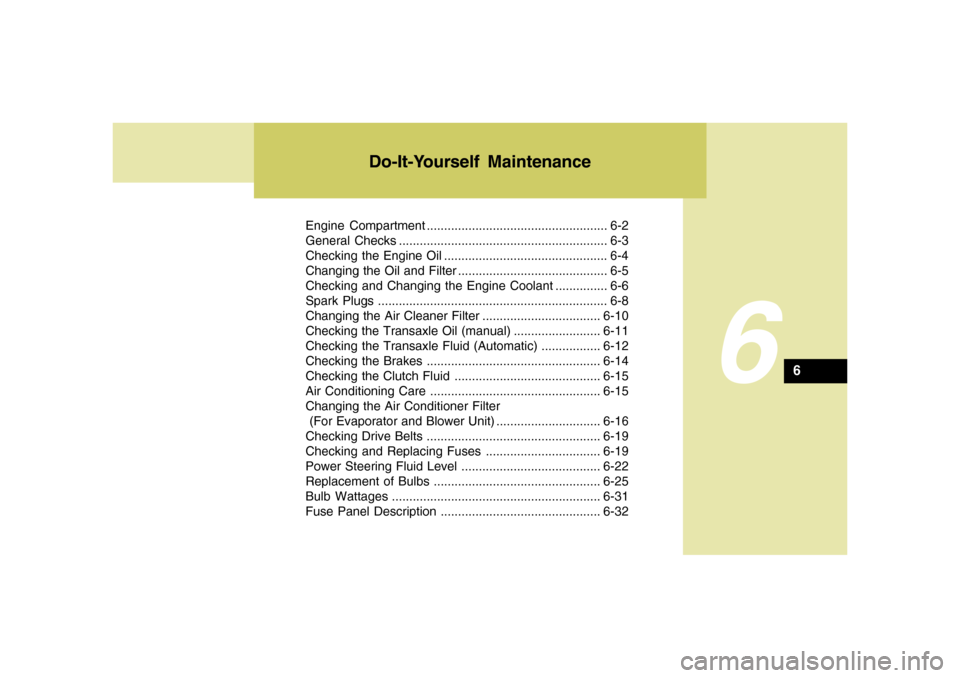
Engine Compartment .................................................... 6-2
General Checks ............................................................ 6-3
Checking the Engine Oil ............................................... 6-4
Changing the Oil and Filter ........................................... 6-5
Checking and Changing the Engine Coolant ............... 6-6
Spark Plugs .................................................................. 6-8
Changing the Air Cleaner Filter ..................................6-10
Checking the Transaxle Oil (manual) .........................6-11
Checking the Transaxle Fluid (Automatic) .................6-12
Checking the Brakes ..................................................6-14
Checking the Clutch Fluid ..........................................6-15
Air Conditioning Care .................................................6-15
Changing the Air Conditioner Filter
(For Evaporator and Blower Unit) ..............................6-16
Checking Drive Belts ..................................................6-19
Checking and Replacing Fuses .................................6-19
Power Steering Fluid Level ........................................6-22
Replacement of Bulbs ................................................6-25
Bulb Wattages ............................................................6-31
Fuse Panel Description ..............................................6-32
Do-It-Yourself Maintenance
6
6
Page 158 of 219
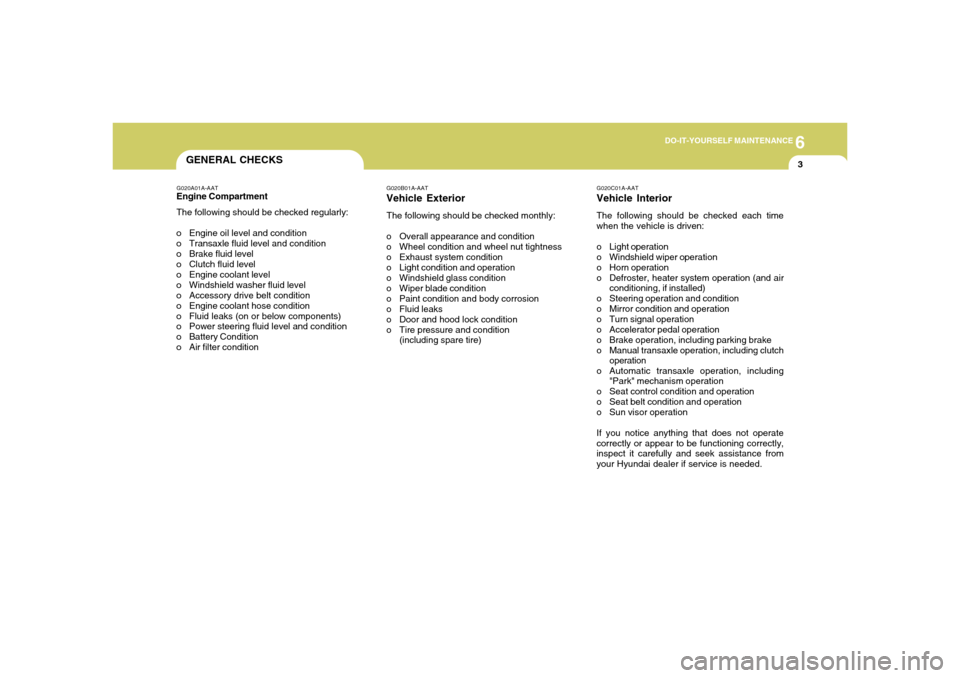
6
DO-IT-YOURSELF MAINTENANCE
3
GENERAL CHECKS
G020C01A-AATVehicle InteriorThe following should be checked each time
when the vehicle is driven:
o Light operation
o Windshield wiper operation
o Horn operation
o Defroster, heater system operation (and air
conditioning, if installed)
o Steering operation and condition
o Mirror condition and operation
o Turn signal operation
o Accelerator pedal operation
o Brake operation, including parking brake
o Manual transaxle operation, including clutch
operation
o Automatic transaxle operation, including
"Park" mechanism operation
o Seat control condition and operation
o Seat belt condition and operation
o Sun visor operation
If you notice anything that does not operate
correctly or appear to be functioning correctly,
inspect it carefully and seek assistance from
your Hyundai dealer if service is needed.
G020A01A-AATEngine Compartment
The following should be checked regularly:
o Engine oil level and condition
o Transaxle fluid level and condition
o Brake fluid level
o Clutch fluid level
o Engine coolant level
o Windshield washer fluid level
o Accessory drive belt condition
o Engine coolant hose condition
o Fluid leaks (on or below components)
o Power steering fluid level and condition
o Battery Condition
o Air filter condition
G020B01A-AATVehicle ExteriorThe following should be checked monthly:
o Overall appearance and condition
o Wheel condition and wheel nut tightness
o Exhaust system condition
o Light condition and operation
o Windshield glass condition
o Wiper blade condition
o Paint condition and body corrosion
o Fluid leaks
o Door and hood lock condition
o Tire pressure and condition
(including spare tire)
Page 159 of 219
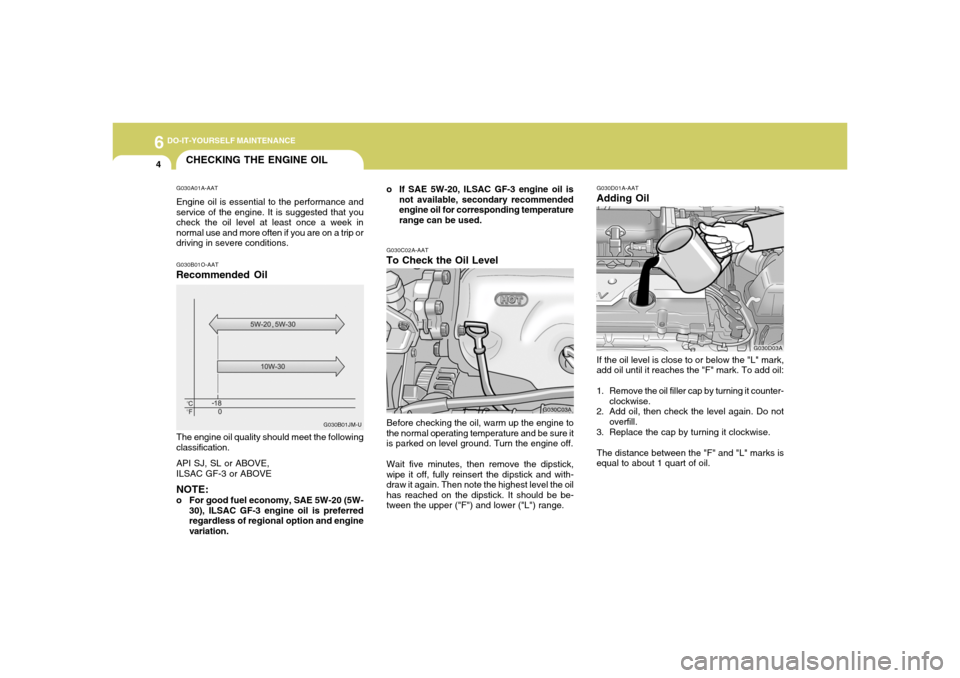
6
DO-IT-YOURSELF MAINTENANCE4
CHECKING THE ENGINE OILG030A01A-AATEngine oil is essential to the performance and
service of the engine. It is suggested that you
check the oil level at least once a week in
normal use and more often if you are on a trip or
driving in severe conditions.
G030C02A-AATTo Check the Oil LevelBefore checking the oil, warm up the engine to
the normal operating temperature and be sure it
is parked on level ground. Turn the engine off.
Wait five minutes, then remove the dipstick,
wipe it off, fully reinsert the dipstick and with-
draw it again. Then note the highest level the oil
has reached on the dipstick. It should be be-
tween the upper ("F") and lower ("L") range.
G030D01A-AATAdding OilIf the oil level is close to or below the "L" mark,
add oil until it reaches the "F" mark. To add oil:
1. Remove the oil filler cap by turning it counter-
clockwise.
2. Add oil, then check the level again. Do not
overfill.
3. Replace the cap by turning it clockwise.
The distance between the "F" and "L" marks is
equal to about 1 quart of oil.
G030C03A
G030D03A G030B01O-AAT
Recommended OilThe engine oil quality should meet the following
classification.
API SJ, SL or ABOVE,
ILSAC GF-3 or ABOVENOTE:o For good fuel economy, SAE 5W-20 (5W-
30), ILSAC GF-3 engine oil is preferred
regardless of regional option and engine
variation.
G030B01JM-U
o If SAE 5W-20, ILSAC GF-3 engine oil is
not available, secondary recommended
engine oil for corresponding temperature
range can be used.
Page 160 of 219
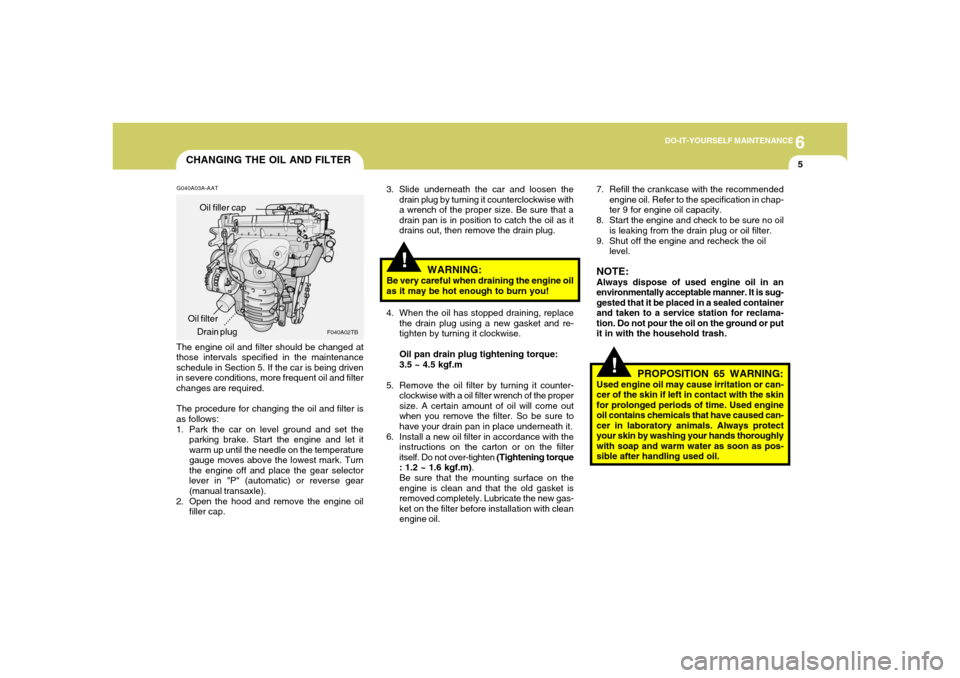
6
DO-IT-YOURSELF MAINTENANCE
5
CHANGING THE OIL AND FILTER
!
G040A03A-AAT
3. Slide underneath the car and loosen the
drain plug by turning it counterclockwise with
a wrench of the proper size. Be sure that a
drain pan is in position to catch the oil as it
drains out, then remove the drain plug.
F040A02TB
Oil filler cap
Drain plug Oil filter
.........
WARNING:
Be very careful when draining the engine oil
as it may be hot enough to burn you!
4. When the oil has stopped draining, replace
the drain plug using a new gasket and re-
tighten by turning it clockwise.
Oil pan drain plug tightening torque:
3.5 ~ 4.5 kgf.m
5. Remove the oil filter by turning it counter-
clockwise with a oil filter wrench of the proper
size. A certain amount of oil will come out
when you remove the filter. So be sure to
have your drain pan in place underneath it.
6. Install a new oil filter in accordance with the
instructions on the carton or on the filter
itself. Do not over-tighten (Tightening torque
: 1.2 ~ 1.6 kgf.m).
Be sure that the mounting surface on the
engine is clean and that the old gasket is
removed completely. Lubricate the new gas-
ket on the filter before installation with clean
engine oil.7. Refill the crankcase with the recommended
engine oil. Refer to the specification in chap-
ter 9 for engine oil capacity.
8. Start the engine and check to be sure no oil
is leaking from the drain plug or oil filter.
9. Shut off the engine and recheck the oil
level.
NOTE:Always dispose of used engine oil in an
environmentally acceptable manner. It is sug-
gested that it be placed in a sealed container
and taken to a service station for reclama-
tion. Do not pour the oil on the ground or put
it in with the household trash.
The engine oil and filter should be changed at
those intervals specified in the maintenance
schedule in Section 5. If the car is being driven
in severe conditions, more frequent oil and filter
changes are required.
The procedure for changing the oil and filter is
as follows:
1. Park the car on level ground and set the
parking brake. Start the engine and let it
warm up until the needle on the temperature
gauge moves above the lowest mark. Turn
the engine off and place the gear selector
lever in "P" (automatic) or reverse gear
(manual transaxle).
2. Open the hood and remove the engine oil
filler cap.
!
PROPOSITION 65 WARNING:
Used engine oil may cause irritation or can-
cer of the skin if left in contact with the skin
for prolonged periods of time. Used engine
oil contains chemicals that have caused can-
cer in laboratory animals. Always protect
your skin by washing your hands thoroughly
with soap and warm water as soon as pos-
sible after handling used oil.
Page 166 of 219
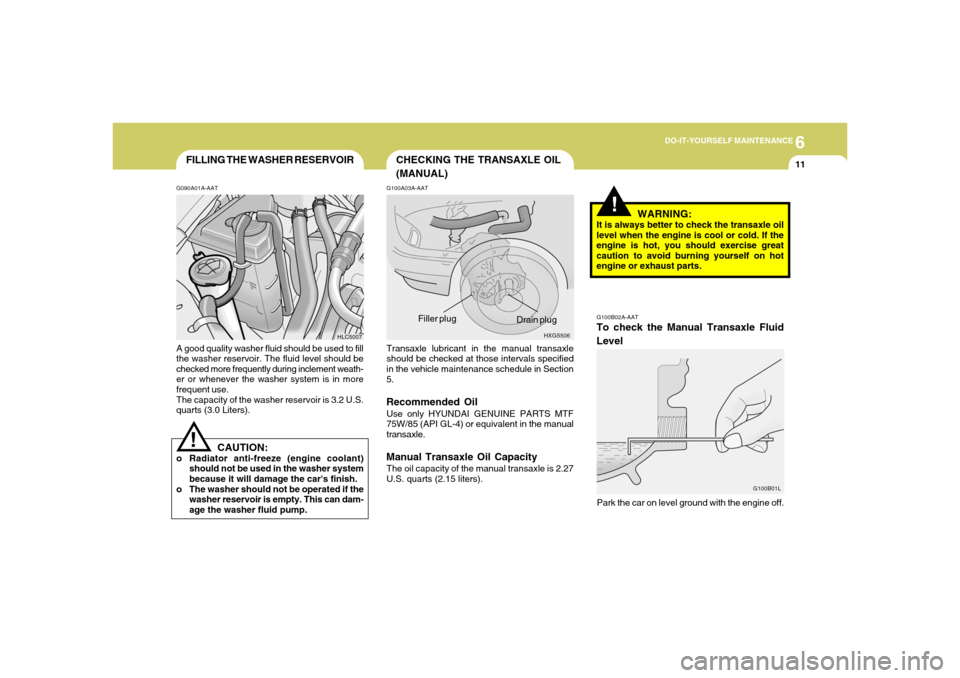
6
DO-IT-YOURSELF MAINTENANCE
11
CHECKING THE TRANSAXLE OIL
(MANUAL)
FILLING THE WASHER RESERVOIRG090A01A-AATA good quality washer fluid should be used to fill
the washer reservoir. The fluid level should be
checked more frequently during inclement weath-
er or whenever the washer system is in more
frequent use.
The capacity of the washer reservoir is 3.2 U.S.
quarts (3.0 Liters).
CAUTION:
o Radiator anti-freeze (engine coolant)
should not be used in the washer system
because it will damage the car's finish.
o The washer should not be operated if the
washer reservoir is empty. This can dam-
age the washer fluid pump.
!
G100A03A-AATTransaxle lubricant in the manual transaxle
should be checked at those intervals specified
in the vehicle maintenance schedule in Section
5.Recommended OilUse only HYUNDAI GENUINE PARTS MTF
75W/85 (API GL-4) or equivalent in the manual
transaxle.Manual Transaxle Oil CapacityThe oil capacity of the manual transaxle is 2.27
U.S. quarts (2.15 liters).
HLC5007HXGS506
Drain plug Filler plug
!
WARNING:
It is always better to check the transaxle oil
level when the engine is cool or cold. If the
engine is hot, you should exercise great
caution to avoid burning yourself on hot
engine or exhaust parts.G100B02A-AATTo check the Manual Transaxle Fluid
LevelPark the car on level ground with the engine off.
G100B01L
Page 167 of 219
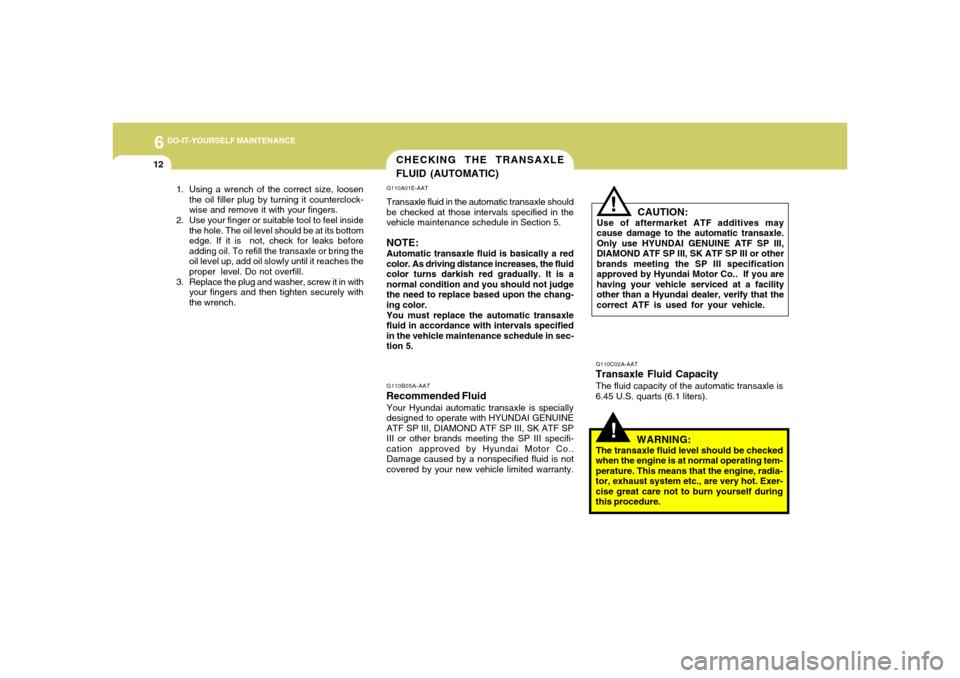
6
DO-IT-YOURSELF MAINTENANCE
12
CHECKING THE TRANSAXLE
FLUID (AUTOMATIC)
!
G110A01E-AATTransaxle fluid in the automatic transaxle should
be checked at those intervals specified in the
vehicle maintenance schedule in Section 5.NOTE:Automatic transaxle fluid is basically a red
color. As driving distance increases, the fluid
color turns darkish red gradually. It is a
normal condition and you should not judge
the need to replace based upon the chang-
ing color.
You must replace the automatic transaxle
fluid in accordance with intervals specified
in the vehicle maintenance schedule in sec-
tion 5.
G110C02A-AATTransaxle Fluid CapacityThe fluid capacity of the automatic transaxle is
6.45 U.S. quarts (6.1 liters).
WARNING:
The transaxle fluid level should be checked
when the engine is at normal operating tem-
perature. This means that the engine, radia-
tor, exhaust system etc., are very hot. Exer-
cise great care not to burn yourself during
this procedure. 1. Using a wrench of the correct size, loosen
the oil filler plug by turning it counterclock-
wise and remove it with your fingers.
2. Use your finger or suitable tool to feel inside
the hole. The oil level should be at its bottom
edge. If it is not, check for leaks before
adding oil. To refill the transaxle or bring the
oil level up, add oil slowly until it reaches the
proper level. Do not overfill.
3. Replace the plug and washer, screw it in with
your fingers and then tighten securely with
the wrench.
!
G110B05A-AATRecommended FluidYour Hyundai automatic transaxle is specially
designed to operate with HYUNDAI GENUINE
ATF SP III, DIAMOND ATF SP III, SK ATF SP
III or other brands meeting the SP III specifi-
cation approved by Hyundai Motor Co..
Damage caused by a nonspecified fluid is not
covered by your new vehicle limited warranty.
CAUTION:
Use of aftermarket ATF additives may
cause damage to the automatic transaxle.
Only use HYUNDAI GENUINE ATF SP III,
DIAMOND ATF SP III, SK ATF SP III or other
brands meeting the SP III specification
approved by Hyundai Motor Co.. If you are
having your vehicle serviced at a facility
other than a Hyundai dealer, verify that the
correct ATF is used for your vehicle.
Page 176 of 219
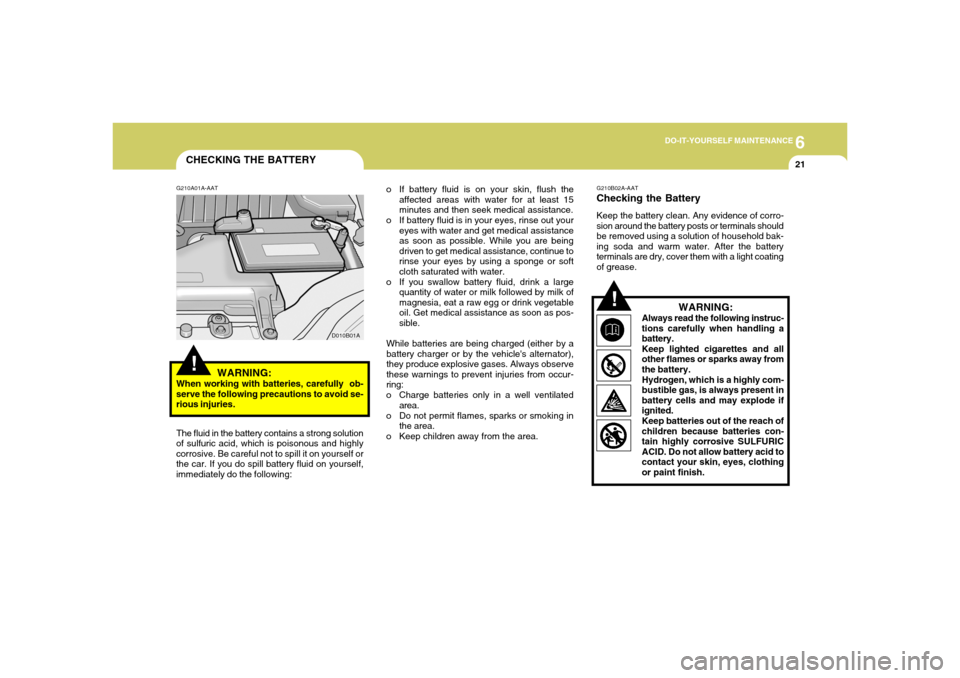
6
DO-IT-YOURSELF MAINTENANCE
21
CHECKING THE BATTERY!
G210A01A-AAT
WARNING:
When working with batteries, carefully ob-
serve the following precautions to avoid se-
rious injuries.o If battery fluid is on your skin, flush the
affected areas with water for at least 15
minutes and then seek medical assistance.
o If battery fluid is in your eyes, rinse out your
eyes with water and get medical assistance
as soon as possible. While you are being
driven to get medical assistance, continue to
rinse your eyes by using a sponge or soft
cloth saturated with water.
o If you swallow battery fluid, drink a large
quantity of water or milk followed by milk of
magnesia, eat a raw egg or drink vegetable
oil. Get medical assistance as soon as pos-
sible.
While batteries are being charged (either by a
battery charger or by the vehicle's alternator),
they produce explosive gases. Always observe
these warnings to prevent injuries from occur-
ring:
o Charge batteries only in a well ventilated
area.
o Do not permit flames, sparks or smoking in
the area.
o Keep children away from the area.
D010B01A
The fluid in the battery contains a strong solution
of sulfuric acid, which is poisonous and highly
corrosive. Be careful not to spill it on yourself or
the car. If you do spill battery fluid on yourself,
immediately do the following:
G210B02A-AATChecking the BatteryKeep the battery clean. Any evidence of corro-
sion around the battery posts or terminals should
be removed using a solution of household bak-
ing soda and warm water. After the battery
terminals are dry, cover them with a light coating
of grease.
WARNING:
Always read the following instruc-
tions carefully when handling a
battery.
Keep lighted cigarettes and all
other flames or sparks away from
the battery.
Hydrogen, which is a highly com-
bustible gas, is always present in
battery cells and may explode if
ignited.
Keep batteries out of the reach of
children because batteries con-
tain highly corrosive SULFURIC
ACID. Do not allow battery acid to
contact your skin, eyes, clothing
or paint finish.
!
Page 178 of 219
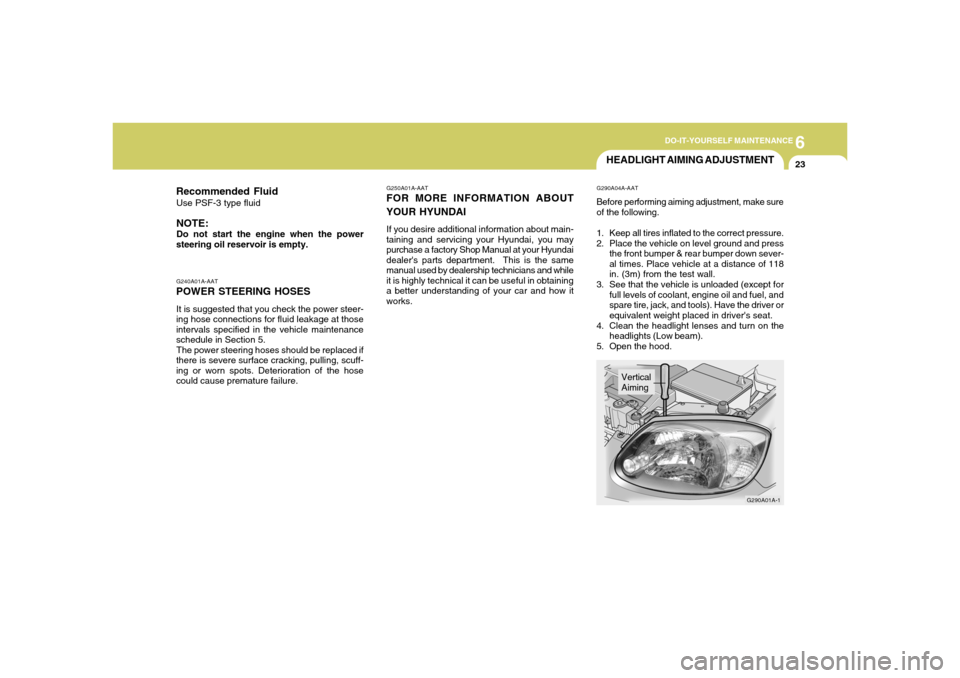
6
DO-IT-YOURSELF MAINTENANCE
23
G240A01A-AATPOWER STEERING HOSESIt is suggested that you check the power steer-
ing hose connections for fluid leakage at those
intervals specified in the vehicle maintenance
schedule in Section 5.
The power steering hoses should be replaced if
there is severe surface cracking, pulling, scuff-
ing or worn spots. Deterioration of the hose
could cause premature failure.Recommended FluidUse PSF-3 type fluidNOTE:Do not start the engine when the power
steering oil reservoir is empty.
HEADLIGHT AIMING ADJUSTMENT
G250A01A-AATFOR MORE INFORMATION ABOUT
YOUR HYUNDAIIf you desire additional information about main-
taining and servicing your Hyundai, you may
purchase a factory Shop Manual at your Hyundai
dealer's parts department. This is the same
manual used by dealership technicians and while
it is highly technical it can be useful in obtaining
a better understanding of your car and how it
works.
G290A04A-AATBefore performing aiming adjustment, make sure
of the following.
1. Keep all tires inflated to the correct pressure.
2. Place the vehicle on level ground and press
the front bumper & rear bumper down sever-
al times. Place vehicle at a distance of 118
in. (3m) from the test wall.
3. See that the vehicle is unloaded (except for
full levels of coolant, engine oil and fuel, and
spare tire, jack, and tools). Have the driver or
equivalent weight placed in driver's seat.
4. Clean the headlight lenses and turn on the
headlights (Low beam).
5. Open the hood.
G290A01A-1
Vertical
Aiming
Page 215 of 219
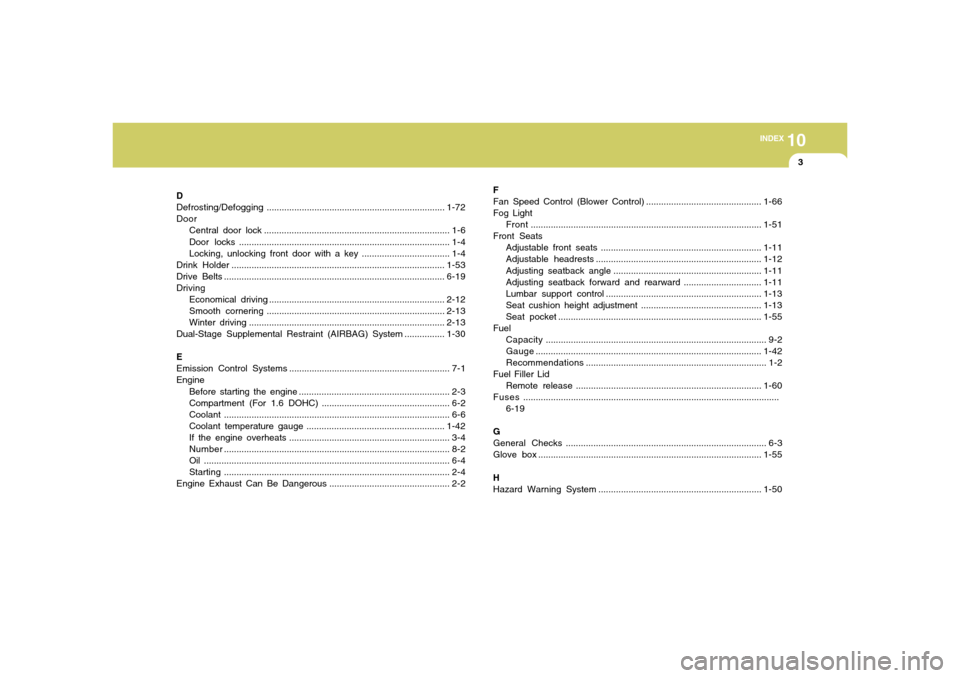
10
INDEX
3
D
Defrosting/Defogging.......................................................................1-72
Door
Central door lock .......................................................................... 1-6
Door locks.................................................................................... 1-4
Locking, unlocking front door with a key ................................... 1-4
Drink Holder.....................................................................................1-53
Drive Belts........................................................................................6-19
Driving
Economical driving......................................................................2-12
Smooth cornering.......................................................................2-13
Winter driving..............................................................................2-13
Dual-Stage Supplemental Restraint (AIRBAG) System ................1-30
E
Emission Control Systems................................................................ 7-1
Engine
Before starting the engine ............................................................ 2-3
Compartment (For 1.6 DOHC) ................................................... 6-2
Coolant.......................................................................................... 6-6
Coolant temperature gauge .......................................................1-42
If the engine overheats ................................................................ 3-4
Number.......................................................................................... 8-2
Oil .................................................................................................. 6-4
Starting.......................................................................................... 2-4
Engine Exhaust Can Be Dangerous ................................................ 2-2F
Fan Speed Control (Blower Control)..............................................1-66
Fog Light
Front............................................................................................1-51
Front Seats
Adjustable front seats ................................................................1-11
Adjustable headrests..................................................................1-12
Adjusting seatback angle ...........................................................1-11
Adjusting seatback forward and rearward...............................1-11
Lumbar support control ..............................................................1-13
Seat cushion height adjustment................................................1-13
Seat pocket.................................................................................1-55
Fuel
Capacity........................................................................................ 9-2
Gauge..........................................................................................1-42
Recommendations........................................................................ 1-2
Fuel Filler Lid
Remote release..........................................................................1-60
Fuses ......................................................................................................
6-19
G
General Checks................................................................................ 6-3
Glove box.........................................................................................1-55
H
Hazard Warning System .................................................................1-50
Page 217 of 219
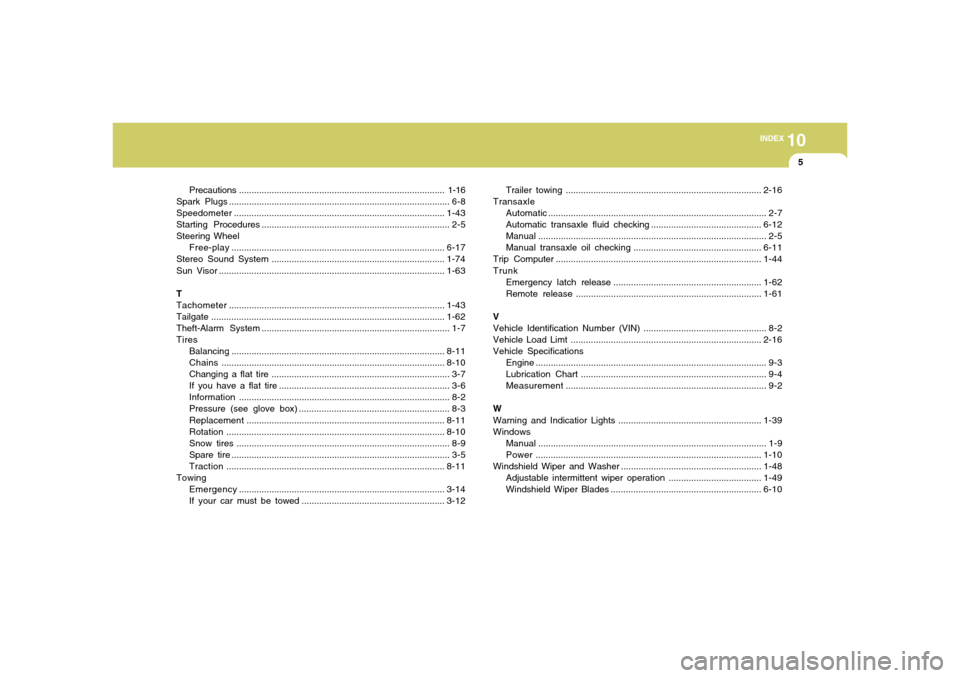
10
INDEX
5
Precautions..................................................................................1-16
Spark Plugs........................................................................................ 6-8
Speedometer....................................................................................1-43
Starting Procedures........................................................................... 2-5
Steering Wheel
Free-play.....................................................................................6-17
Stereo Sound System.....................................................................1-74
Sun Visor..........................................................................................1-63
T
Tachometer......................................................................................1-43
Tailgate .............................................................................................1-62
Theft-Alarm System........................................................................... 1-7
Tires
Balancing.....................................................................................8-11
Chains.........................................................................................8-10
Changing a flat tire ....................................................................... 3-7
If you have a flat tire .................................................................... 3-6
Information.................................................................................... 8-2
Pressure (see glove box) ............................................................ 8-3
Replacement...............................................................................8-11
Rotation.......................................................................................8-10
Snow tires..................................................................................... 8-9
Spare tire....................................................................................... 3-5
Traction.......................................................................................8-11
Towing
Emergency..................................................................................3-14
If your car must be towed .........................................................3-12Trailer towing..............................................................................2-16
Transaxle
Automatic....................................................................................... 2-7
Automatic transaxle fluid checking ............................................6-12
Manual........................................................................................... 2-5
Manual transaxle oil checking...................................................6-11
Trip Computer..................................................................................1-44
Trunk
Emergency latch release ...........................................................1-62
Remote release..........................................................................1-61
V
Vehicle Identification Number (VIN) ................................................. 8-2
Vehicle Load Limt ............................................................................2-16
Vehicle Specifications
Engine ............................................................................................ 9-3
Lubrication Chart.......................................................................... 9-4
Measurement................................................................................ 9-2
W
Warning and Indicatior Lights .........................................................
1-39
Windows
Manual........................................................................................... 1-9
Power..........................................................................................1-10
Windshield Wiper and Washer ........................................................1-48
Adjustable intermittent wiper operation.....................................1-49
Windshield Wiper Blades ............................................................6-10